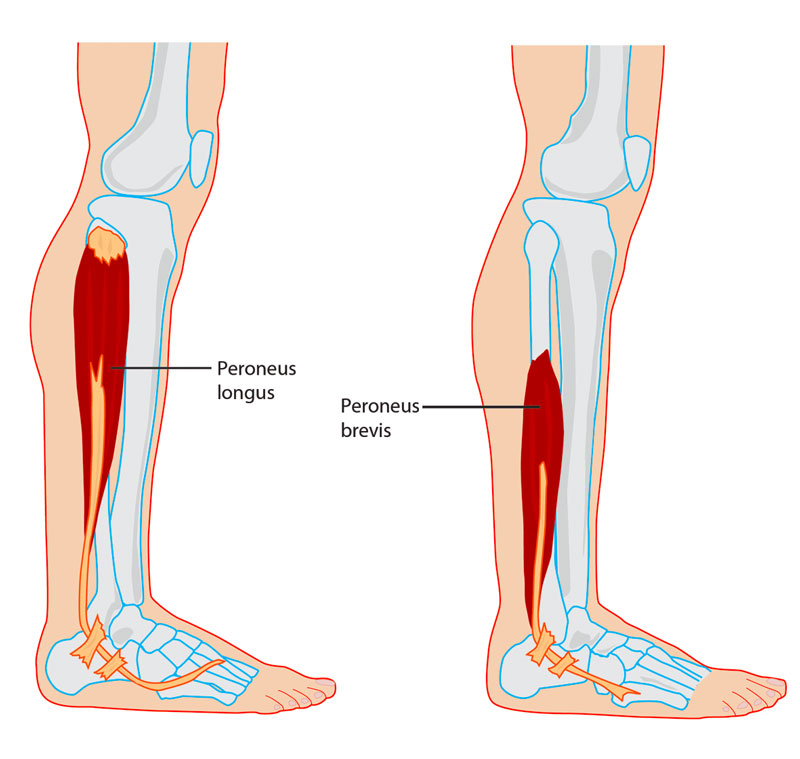What is Peroneal Tendinopathy?
Peroneal tendinopathy is a condition that affects the peroneal tendons located on the outside of the ankle. These tendons play a role in stabilising the foot and ankle during movement. When these tendons are overloaded, they can become inflamed leading to pain and discomfort. This condition is common among athletes, especially walker and runners, but can also affect those with biomechanical issues in the foot or ankle.

What are the symptoms of Peroneal Tendinopathy?
The symptoms of peroneal tendinopathy can range from mild to severe, depending on the extent of the injury. Some common symptoms include:
- Pain along the outside of the ankle or foot: This is often the most noticeable symptom, particularly during physical activity.
- Swelling or tenderness: The area around the peroneal tendons may become swollen and sensitive to touch.
- Weakness or instability: You may experience a feeling of weakness or instability in the ankle, particularly when walking on uneven surfaces.
- Stiffness or reduced range of motion: The ankle may feel stiff, especially after periods of rest, and you might find it difficult to move the foot freely.
What causes Peroneal Tendinopathy?
There are several factors that can contribute to the development of peroneal tendinopathy, including:
- Overuse: Repetitive movements, such as running, can place excessive strain on the peroneal tendons.
- Poor footwear: Wearing shoes that don’t provide adequate support or cushioning can increase the risk of developing this condition.
- Foot posture issues: People with high arches or flat feet may be more prone to peroneal tendinopathy due to the increased loading of the tendons.
- Previous ankle injuries: A history of ankle sprains or other injuries can make the peroneal tendons more vulnerable to injury.
How is Peroneal Tendinopathy diagnosed?
A diagnosis of peroneal tendinopathy is usually made through a physical examination by a Podiatrist or Physiotherapist. Your clinician will assess your symptoms and may perform certain tests, such as:
- Resisted muscle testing: Trying to work the peroneals against increased resistence can reproduce symptoms.
- Palpation: Pressing on the peroneal tendons to check for pain or tenderness.
- Imaging tests: In some cases, imaging studies such as ultrasound or MRI may be ordered to assess the severity of the damage to the tendons. Especially if a tear is suspected.
What are the treatment options for Peroneal Tendinopathy?
Treatment for peroneal tendinopathy typically involves a combination of rest, physical therapy, and supportive measures. Some common treatment options include:
- Rest and activity modification: Reducing or avoiding activities that aggravate the condition is essential for allowing the tendons to heal.
- Ice: Applying ice to the affected area can help reduce inflammation and relieve pain in the early stages.
- Supportive footwear: Wearing shoes with good support and cushioning can help reduce strain on the peroneal tendons.
- Orthotics: Custom-made orthotics can help correct any biomechanical issues that may be a factor.
- Physical therapy: Strengthening exercises for the ankle and lower leg can help improve stability and reduce the risk of future injuries.
Can Peroneal Tendinopathy be prevented?
There are several steps you can take to reduce your risk of developing peroneal tendinopathy:
- Wear proper footwear: Ensure your shoes provide adequate support and cushioning, particularly if you engage in high-impact activities like running.
- Gradually increase activity levels: Avoid sudden increases in physical activity, as this can place excessive strain on the tendons.
- Strengthen the ankle and lower leg muscles: Regularly performing exercises that target the muscles around the ankle can help improve stability and reduce the risk of injury.
- Listen to your body: If you start to experience pain or discomfort in your ankle, don’t ignore it. Early intervention can help prevent a minor issue from becoming a more serious injury.
When should you see a podiatrist?
If you’re experiencing persistent pain or discomfort on the outside of your ankle, it’s essential to seek professional help. We can provide an accurate diagnosis and develop a tailored treatment plan to help you recover and prevent further injury.
Peroneal tendinopathy can be managed effectively with early intervention and the right care. If you’re concerned about ankle pain or would like more information, don’t hesitate to contact us or book online.
